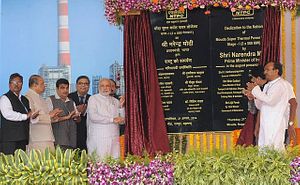Prime Minister Narendra Modi recently inaugurated the Madhya Pradesh Investors Summit on October 8, reiterating that states have to be proactive in attracting foreign investment and that the central government should act as a facilitator.
The prime minister said that “investment worth a $100 billion dollars had applied for a visa to India,” referring to commitments made recently by Japan, China, and businesses in the U.S. Modi also made the point that while the national government can be supportive of efforts made by states to attract foreign investment, much depends ultimately upon the state governments.
As chief minister of Gujarat, Modi was extremely aggressive in selling his state to the outside world, and reached out to a number of countries in Asia such as Japan, China and Singapore. In addition, Modi also started the Vibrant Gujarat Summit in 2003, which was attended by foreign investors and diplomats. Since becoming prime minister, Modi has made a number of recommendations for increasing the role of state governments in economic diplomacy. In addition to the states’ need for their own representatives overseas in order to attract foreign investment, Modi has also spoken about the need to grant greater power to state export councils.
What is interesting about the Madhya Pradesh Investors Summit is that, until a few years ago, Madhya Pradesh was considered a “Bimaru State,” a term coined in the mid 1980s by using the first letters of Bihar, Uttar Pradesh, Madhya Pradesh and Rajasthan, which were considered economic laggards. Over the past decade, though, things have begun to change, with states like Bihar growing impressively. A large portion of the credit for Bihar’s turn around should go to former Chief Minister Nitish Kumar, who helped improve law and order and aggressively marketed his state.
Madhya Pradesh, under the stewardship of Shivraj Singh Chauhan, has also been delivering staggering growth rates. Over the past three years, the state’s average GDP growth has been 10 percent, with growth for 2013-2014 increasing to 11.08 percent. Both domestic and foreign investors have begun to show interest in the state. At the recent investment summit, commitments of more than $32.7 billion were made by investors. Anil Ambani, Chairman of Reliance Group; Mukesh Ambani, Chairman of RIL; and Gautam Adani, Chairman of Adani Group committed investments worth more than $16 billion.
It would be fair to point out that a number of investors who made commitments in earlier summits have not followed through, citing bureaucratic red tape and logistical problems as key reasons. It would also be pertinent to point out that the key driver of Madhya Pradesh’s economic growth has been an impressive growth rate in agriculture, averaging 20 percent for the last three years. Industrial growth has not been particularly impressive over the past two years, at 2.1 percent in 2013-14, down from 5.5 percent in 2012-13.
Consequently, the euphoria regarding Madhya Pradesh’s growth needs to be tempered with reality. It is indeed a welcome development that those states that were never part of the national discourse on growth and development, are beginning to take the lead in attracting foreign investment, and want to be stakeholders in India’s march toward economic growth.
This will also help in making economic growth more equitable and widely distributed. Currently, a handful of states like Maharashtra, Gujarat and New Delhi receive the bulk of foreign direct investment (FDI), while even domestic businesses prefer safer options. Other states with effective governments and strong leaders, such as Orissa and Tripura, can also begin to sell themselves as Madhya Pradesh has. While states like Orissa are well endowed in terms of natural resources, those like Tripura have economic potential and are also well located. The latter could be India’s gateway to Bangladesh.
In addition to equitable growth, it is also important that state governments that are not run by the ruling BJP are not discriminated against. Modi alluded to this point in his speech made at the Madhya Pradesh Investors Summit, saying that foreign investment benefits the whole country and not just a particular state, and in this sense the political affiliation of a state government should be irrelevant.
While proactive states are an encouraging sign, it is also important that the number of states projecting their economic potential increases. Comparisons between China and India are very frequent. However, there are significant differences in the political systems of both countries, and the former’s economic growth trajectory has been much steeper. One area where India can emulate China is by creating healthy competition among states in drawing foreign investors. A number of underdeveloped regions like Yunnan have been able to develop in this way. States in Eastern India as well as the north-east, if given the required support, could not just become part of the country’s growth story, but provide an even greater boost.
Tridivesh Singh Maini is a Senior Research Associate with The Jindal School of International Affairs, Sonepat.

































